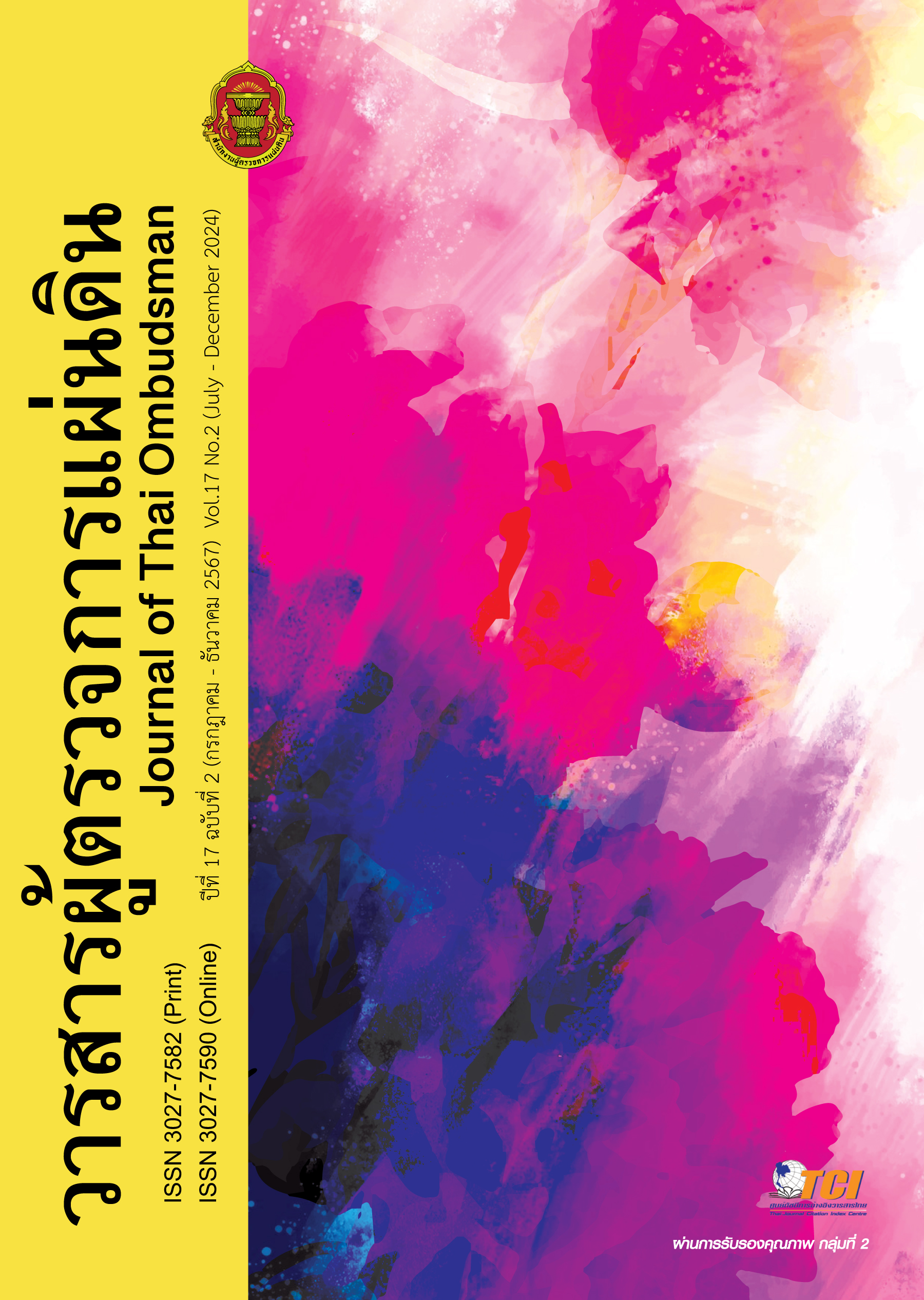THE RIGHT TO SUBMIT A PETITION TO THE CONSTITUTIONAL COURT OF THAILAND SYSTEM IN CASE OF ACTS THAT VIOLATE RIGHTS AND LIBERTIES GUARANTEED BY THE CONSTITUTION
Keywords:
Problems, System, Decision, Constitutional Court, OmbudsmanAbstract
The purpose of this article aims at studying the problems, the concepts, the procedures and the systems of rights to submission to the Constitutional Court for acts that violate constitutional rights and freedoms system according to the Constitution of the Kingdom of Thailand (B.E. 2560), section 213, and the Organic Act on Procedures of the Constitutional Court B.E. 2561. The matter of study is compared to the country which principle of the right has been developed. The result of study is that this right has four problems : (1) the system of submitting rights that overlaps between the rights of the Ombudsman and individual and the object of the case that overlaps in case of the provisions of the law ; (2) the Ombudsman's screening system that lacks the criteria for classifying cases under the implementation of the articles 213 and 231 (1) of Constitution B.E. 2560 and the screening under the excemption of Article 47 of the Constitutional Act on the Procedure of the Constitutional Court B.E. 2561. (3) the structural and procedural system that the number of justices are not consistent with the authority and duties under section 213 of the Constitution B.E. 2560 and the judicial procedures of the Constitutional Court, which has not yet prescibed a specific procedure for this case. (4) the interpretation of Constitutional Court that tend to remedy the rights of the individual but result from ruling that extend jurisdiction and inconsistent with the legal system and jurisdiction of other courts, and (5) the system of right to submit a petition to defend rights and liberties to the courts in parallel system which causes delays in justice and uncertainty whether the rights and liberties will be protected and conformed, as well as the judgment of various courts that may conflict each other. This article proposes to improve the system for the right in 4 ways : (1) prescribing the discretion to submit petitions to constitutional organs if there are acts that are contrary to the Constitution and violate the rights of the people that should be considered by the Constitutional Court. (2) setting conditions for receiving petitions only in cases that are important for formulating the fundamental principle for the necessary interpretation of the Constitution or laying the guidelines for the implementation of state organs in accordance with the Constitution. (3) applying the screening cases mechanism by relying on the affirmation system from the panel of the Constitutional Court or persons holding positions in the independent organs that implements the remedy for damages. and (4) improving the qualifications of the Ombudsman with knowledge and experience related to the protection of rights and liberties or the public law in accord with the role of screening and developing constitutional principles and public law from the Ombudsman's adjudication duties.
References
กุญชนิตา กุญชร ณ อยุธยา. (2561). ปัญหาเขตอำนาจศาลรัฐธรรมนูญ : ศึกษากรณีมาตรา 213 รัฐธรรมนูญแห่งราชอาณาจักรไทย พุทธศักราช 2560. วิทยานิพนธ์นิติศาสตรมหาบัณฑิตสาขากฎหมายมหาชน คณะนิติศาสตร์ มหาวิทยาลัยธรรมศาสตร์.
เฉลิมพงษ์ ถือดียิ่ง. (2555). ปัญหาผู้มีอํานาจฟ้องคดีต่อศาลรัฐธรรมนูญ. วิทยานิพนธ์ปริญญานิติศาสตรมหาบัณฑิต สาขากฎหมายมหาชน คณะนิติศาสตร์ มหาวิทยาลัยธรรมศาสตร์.
ต่อพงศ์ กิตติยานุพงศ์. (2564). เมื่อศาลรัฐธรรมนูญตั้งตนเหนือศาลอื่น : พิทักษ์หรือบั่นทอนรัฐธรรมนูญ?. ค้นเมื่อ 25 กรกฎาคม 2567. จาก https://www.the101.world/constitutional- complaint/
นภนันทน์ จันทราชโลธร. (2565). การคุ้มครองสิทธิและเสรีภาพตามรัฐธรรมนูญโดยศาลรัฐธรรมนูญ. วิทยานิพนธ์ปริญญานิติศาสตรดุษฎีบัณฑิต คณะนิติศาสตร์ มหาวิทยาลัยธรรมศาสตร์.
นําพงษ์ ไกยเดช. (2554). การกําหนดคุณสมบัติและกระบวนการสรรหากับความเป็นอิสระของตุลาการศาลรัฐธรรมนูญ : ศึกษาเปรียบเทียบกับศาลรัฐธรรมนูญของประเทศสหพันธ์สาธารณรัฐเยอรมนี สหรัฐอเมริกา สาธารณรัฐเกาหลี และญี่ปุ่น. วิทยานิพนธ์ปริญญานิติศาสตรมหาบัณฑิต มหาวิทยาลัยสุโขทัยธรรมาธิราช.
มหาวิทยาลัยแม่ฟ้าหลวง. (2563). รายงานการศึกษาวิจัย เรื่อง อำนาจของศาลรัฐธรรมนูญในการวินิจฉัยความชอบด้วยรัฐธรรมนูญของการกระทำตามรัฐธรรมนูญแห่งราชอาณาจักรไทย พุทธศักราช 2560 มาตรา 213 และพระราชบัญญัติประกอบรัฐธรรมนูญว่าด้วยวิธีพิจารณาของศาลรัฐธรรมนูญ พ.ศ. 2561. กรุงเทพฯ : สำนักงานศาลรัฐธรรมนูญ.
วรเจตน์ ภาคีรัตน์. (2556). ผลผูกพันของสิทธิทางรัฐธรรมนูญ. วารสารนิติศาสตร์,42(4), 993.
สุรศักดิ์ บุญญานุกูลกิจ. (2562). สิทธิของบุคคลในการยื่นคำร้องต่อศาลรัฐธรรมนูญตามมาตรา 213 รัฐธรรมนูญ แห่งราชอาณาจักรไทย พุทธศักราช 2560. รายงานฉบับสมบูรณ์เสนอต่อคณะกรรมการส่งเสริมงานวิจัย คณะนิติศาสตร์ มหาวิทยาลัยธรรมศาสตร์.
สำนักงานศาลรัฐธรรมนูญ. (2564). สรุุปผลการสััมมนาโครงการสััมมนาประเด็็นรััฐธรรมนููญระหว่่างที่่ปรึึกษาและผู้้เชี่่ยวชาญประจำคณะตุุลาการศาลรััฐธรรมนููญ (กรุงเทพฯ : แอคทีีฟพริ้นท์์ จำกััด)
สำนักงานศาลรัฐธรรมนูญ. (2567). หน้าที่และอำนาจของศาลรัฐธรรมนูญ. ค้นเมื่อ 14 มีนาคม 2567. จาก https://occ_th.constitutionalcourt.or.th/article_detail/
อัชนา ไชยชนะ. (2564). พัฒนาการทางกฎหมายเกี่ยวกับการใช้สิทธิของบุคคลที่ถูกละเมิดสิทธิเสรีภาพในการยื่นคำร้องโดยตรงต่อศาลรัฐธรรมนูญ : ศึกษาปัญหาวัตถุแห่งคดี. วิทยานิพนธ์ปริญญานิติศาสตรมหาบัณฑิต สาขากฎหมายมหาชน คณะนิติศาสตร์ มหาวิทยาลัยธรรมศาสตร์.
Venice Commission. (2010). STUDY ON INDIVIDUAL ACCESS TO CONSTITUTIONAL JUSTICE. Retrieved February 3, 2024, from <https://www.venice.coe.int/webforms/documents/?pdf=CDL-AD(2010)039rev-e.>
Venice Commission (2021). REVISED REPORT ON INDIVIDUAL ACCESS TO CONSTITUTIONAL JUSTICE. Retrieved March 18, 2024, from <https://www.venice.coe.int/webforms/documents/default.aspx?pdffile=CDL-AD(2021)001-e.>
Downloads
Published
How to Cite
Issue
Section
License
Copyright (c) 2024 Office of the Ombudsman

This work is licensed under a Creative Commons Attribution-NonCommercial-NoDerivatives 4.0 International License.
- Content published in the journal is personal opinions of authors which the office of Ombudsman and the editorial team are not bound to be accordance with.
- Articles, content, images, etc. published in the Journal of Ombudsman are copyright of the Journal. If any person or entity wants to bring all or part of it to publish or to do any action. Must obtain written permission from the journal's first.



